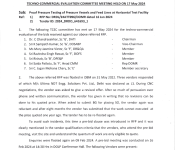You are using an out of date browser. It may not display this or other websites correctly.
You should upgrade or use an alternative browser.
You should upgrade or use an alternative browser.
Please do not share clickbait fiction from that blog. Differentiate between actual journalists and those seeking page views.Wah re corruption.
These kind of publications are not different from bollywood paparazzi writing about filmy gossip.
Believe me bro talks from Kaku are more reliablePlease do not share clickbait fiction from that blog. Differentiate between actual journalists and those seeking page views.
These kind of publications are not different from bollywood paparazzi writing about filmy gossip.

CNC India takes pride in its association with our Space and Defence organizations (ISRO, DRDO) by providing innovative customized solutions in design, fabrication, and integration. We have received SAMAR Assessment Certification.


Indian Army inducts first-ever indigenous chip-based made in India 4G base station from Signaltron
By PTI
Last Updated: Jun 30, 2024, 02:00:00 PM IST

Indian army has inducted the first-ever indigenous chip-based 4G mobile base station, which it procured from Bangalore-based firm Signaltron through the government e-marketplace portal, a top company official said. Signaltron founder Himamshu Khasnis told PTI that the chip used in the Sahyadri LTE base stations has been developed by Signalchip.
Earlier in 2010, Khasnis and his team founded a fabless semiconductor company Signalchip to make chips for 4G and 5G networks.
"Signaltron has built the entire system indigenously using India's first chips for 4G and 5G networks developed by Signalchip. This is the first time an Indian system running on an Indian chip for complex communication technology has been inducted into the army. Using indigenous chips gives a high degree of control on the security of the system in its operation," Khasnis said.
He said the Indian Army had posted a bid on GeM (Government e-Marketplace) for the supply of 4G LTE NIB (Network in a Box) solution last year.
"Signaltron proposed the Sahyadri NIB solution and came out successful in stringent technical trials. Subsequently, Signaltron also won the competitive bid to supply the equipment. Weighing just 7 kgs, Sahyadri Network in Box (NIB) systems provide high-quality secure wireless communication for audio, video and data applications," Khasnis said.
He said the Sahyadri NIB is capable of working in both standalone and cellular modes and capable of seamless inter-operation with legacy analogue and IP telephony systems.
The majority of the base stations deployed in India are not made in India. Even the few that are made in India do not have indigenous chips inside, which is the most strategic and important component of modern electronic devices and equipment.

Signaltron has supplied 20 units to the army and the deployment of the base stations depends on their strategic requirement, Khasnis said.
"We have supplied 20 units to the army. The Army takes its own call on when and where to deploy base station. Since they are light and mobile units, it gives them the flexibility to change the location as per their requirement," he added.
At present, there is no fabrication facility in India for modern semiconductor chips. Signalchip has designed the chip indigenously and owns the entire technology that the chips deliver. In a model similar to leading semiconductor companies like Nvidia, Qualcomm, Mediatek etc, Signalchip also gets its chips fabricated through third-party wafer fabs.
Khasnis said the Indian base station market is expected to be about USD 24 billion by 2029.
"With the use of indigenous systems, there could be significant savings to forex and also boost GDP. There are sizeable market volumes available in India and worldwide. Modernisation targets of different sectors like defence, railways etc. are excellent opportunities for indigenous solutions," he said.
Khasnis said that the CNPN (Captive Network-Private Network) 4G/5G market worldwide is expected to cross USD 30 billion by 2030, which will enable large possibilities for the local chip-based base stations, thereby providing economies of scale.
Indian Army inducts first-ever indigenous chip-based made in India 4G base station from Signaltron
By PTI
Last Updated: Jun 30, 2024, 02:00:00 PM IST
Synopsis
The Indian Army has introduced its first indigenous chip-based 4G mobile base station, procured from Signaltron, a Bangalore-based firm, via the government e-marketplace portal. Developed using India's own Signalchip technology, the Sahyadri LTE base stations mark a significant milestone in domestic communication technology. Signaltron's Sahyadri Network In a Box (NIB) systems, weighing just 7 kgs, offer secure wireless communication for audio, video, and data, operating seamlessly in standalone or cellular modes. With 20 units supplied initially, the army plans strategic deployments based on operational needs, enhancing flexibility and security with locally developed chip technology.
Indian army has inducted the first-ever indigenous chip-based 4G mobile base station, which it procured from Bangalore-based firm Signaltron through the government e-marketplace portal, a top company official said. Signaltron founder Himamshu Khasnis told PTI that the chip used in the Sahyadri LTE base stations has been developed by Signalchip.
Earlier in 2010, Khasnis and his team founded a fabless semiconductor company Signalchip to make chips for 4G and 5G networks.
"Signaltron has built the entire system indigenously using India's first chips for 4G and 5G networks developed by Signalchip. This is the first time an Indian system running on an Indian chip for complex communication technology has been inducted into the army. Using indigenous chips gives a high degree of control on the security of the system in its operation," Khasnis said.
He said the Indian Army had posted a bid on GeM (Government e-Marketplace) for the supply of 4G LTE NIB (Network in a Box) solution last year.
"Signaltron proposed the Sahyadri NIB solution and came out successful in stringent technical trials. Subsequently, Signaltron also won the competitive bid to supply the equipment. Weighing just 7 kgs, Sahyadri Network in Box (NIB) systems provide high-quality secure wireless communication for audio, video and data applications," Khasnis said.
He said the Sahyadri NIB is capable of working in both standalone and cellular modes and capable of seamless inter-operation with legacy analogue and IP telephony systems.
The majority of the base stations deployed in India are not made in India. Even the few that are made in India do not have indigenous chips inside, which is the most strategic and important component of modern electronic devices and equipment.

Signaltron has supplied 20 units to the army and the deployment of the base stations depends on their strategic requirement, Khasnis said.
"We have supplied 20 units to the army. The Army takes its own call on when and where to deploy base station. Since they are light and mobile units, it gives them the flexibility to change the location as per their requirement," he added.
At present, there is no fabrication facility in India for modern semiconductor chips. Signalchip has designed the chip indigenously and owns the entire technology that the chips deliver. In a model similar to leading semiconductor companies like Nvidia, Qualcomm, Mediatek etc, Signalchip also gets its chips fabricated through third-party wafer fabs.
Khasnis said the Indian base station market is expected to be about USD 24 billion by 2029.
"With the use of indigenous systems, there could be significant savings to forex and also boost GDP. There are sizeable market volumes available in India and worldwide. Modernisation targets of different sectors like defence, railways etc. are excellent opportunities for indigenous solutions," he said.
Khasnis said that the CNPN (Captive Network-Private Network) 4G/5G market worldwide is expected to cross USD 30 billion by 2030, which will enable large possibilities for the local chip-based base stations, thereby providing economies of scale.
Indian Army inducts first-ever indigenous chip-based made in India 4G base station from Signaltron
DRDO awards 7 new projects under Technology Development Fund scheme to MSME & startups. Strengthening the forces w/ indigenous tech & fostering a resilient military industrial ecosystem.

DRDO sanctions seven new projects to the private sector under Technology Development Fund scheme
Posted On: 11 JUL 2024 12:39PM by PIB Delhi
Aim is to nurture industries, especially MSMEs & start-ups, in defence and aerospace sectors
Providing impetus to Aatmanirbharta, Defence Research & Development Organisation (DRDO) has awarded seven new projects to industries under the Technology Development Fund scheme for various requirements of the Armed Forces and aerospace & defence sectors. These project sanctions are a testimony to the continuing endeavour of DRDO in nurturing Industries, especially MSMEs & start-ups, in defence and aerospace domains. The indigenous development of these technologies will strengthen the military industrial ecosystem. The details of the sanctioned projects are given below:
Indigenous Scenario and Sensor Simulation Toolkit
The project involves development of an indigenous toolkit for simulator training of pilots in realistic scenarios. This will help in full mission planning and large force engagement. The project has been awarded to start-up, Oxygen 2 Innovation Pvt Ltd, Noida.
Underwater Launched Unmanned Aerial Vehicle
The project relates to a versatile marine battlefield accessories which can be deployed in multiple combat roles. The objective is Intelligence, Surveillance and Reconnaissance (ISR) and Maritime Domain Awareness (MDA). The project has been awarded to Sagar Defence Engineering Pvt Ltd Pune.
Long-range Remotely Operated Vehicles for Detection & Neutralisation
The vehicles are dual-use systems that will enable detection, classification, localisation & neutralisation of underwater objects while keeping the key assets away from the suspected operational area. The project has been awarded to a start-up, IROV Technologies Pvt Limited, Kochi.
Development of Ice Detection Sensor for Aircraft
The project aims to develop detecting icing condition inflight, caused by super cooled water droplets that freezes after their impact against the aircraft external surfaces and is utilised by the aircraft for turning on the aircraft Anti-icing mechanism. It has been awarded to Craftlogic Labs Pvt Ltd, Bengaluru.
Development of Radar Signal Processor with Active Antenna Array Simulator
The project will enable deployment of multiple target system for test and evaluation of multiple short range aerial weapon system. It serves as the basic building block for larger radar systems. The project has been sanctioned to Data Pattern (India) Limited, Chennai.
Development of Indian Regional Navigation Satellite System-based Timing Acquisition & Dissemination System
The project has been sanctioned to Accord Software & Systems Pvt Ltd, Bengaluru. It aims to enable indigenisation of timing acquisition and dissemination system, use of Indian Constellation for acquiring time & development of customised and flexible timing system as per range requirements.
Development of Graphene Based Smart & E-textiles for Multifunctional Wearable Applications
The start-up, Alohatech Private Limited, Coimbatore has been sanctioned the project. It will develop a conductive yarn and fabric-making processes using graphene nanomaterials and conductive inks. The outcome will be advanced nanocomposite materials-based E-textiles utilising the inherent advantages for practical clothing applications.

DRDO sanctions seven new projects to the private sector under Technology Development Fund scheme
Providing impetus to Aatmanirbharta, Defence Research & Development Organisation (DRDO) has awarded
pib.gov.in
There is a news on Zee Biz that Astra mk2 soon will get into production in December after finishing all trials and 3000crores deal possible.
Zen Technologies, India’s leading anti-drone technology and defence training solutions provider, in collaboration with its subsidiary AI Turing Technologies based in Pune, launched four new products today.These IP-owned innovations – Hawkeye, Barbarik-URCWS (Ultralight Remote Control WeaponStation), Prahasta, and Sthir Stab 640 – cater to a wide range of defence requirements, empowering forces with unmatched tactical superiority and enhanced operational efficiency.
1. Hawkeye (zen.in/hawkeye) epitomizes a state-of-the-art anti-drone system camera, featuringmultiple sensor detection modules for all-weather drone tracking up to 15 km. It ensurescontinuous threat detection and enhanced security.
2. Barbarik – URCWS (zen.in/urcws) is the world's lightest remote-controlled weapon station,offering precise targeting capabilities (5.56mm to 7.62mm calibers) for ground vehicles and naval vessels, maximizing battlefield effectiveness while minimizing personnel risk. The URCWS has undergone recent firing trials at Infantry School Mhow and Armoured School Ahmednagar and performed well.
3. Prahasta (zen.in/prahasta) is a revolutionary automated quadruped that uses LIDAR and reinforcement learning to understand and create real-time 3D terrain mapping for unparalleled mission planning, navigation, and threat assessment. The quadruped can be armed with various caliber weapons such as 9mm, 5.56mm, and 7.62mm. The quadruped can be used as the first line of defence for commandos during CI operations like 26/11, thereby saving lives.
4. Sthir Stab 640 (zen.in/sthirstab640) is a rugged stabilized sight designed mainly for armouredvehicles, ICVs, and boats. The sight encompasses an intelligent fiber optic gyro-stabilized systemand delivers exceptional situational awareness with automatic search and tracking capabilities.The sight can be used in different weapon mounts such as 7.62mm, 12.7mm, 20mm, and 30mm.
1. Hawkeye (zen.in/hawkeye) epitomizes a state-of-the-art anti-drone system camera, featuringmultiple sensor detection modules for all-weather drone tracking up to 15 km. It ensurescontinuous threat detection and enhanced security.
2. Barbarik – URCWS (zen.in/urcws) is the world's lightest remote-controlled weapon station,offering precise targeting capabilities (5.56mm to 7.62mm calibers) for ground vehicles and naval vessels, maximizing battlefield effectiveness while minimizing personnel risk. The URCWS has undergone recent firing trials at Infantry School Mhow and Armoured School Ahmednagar and performed well.
3. Prahasta (zen.in/prahasta) is a revolutionary automated quadruped that uses LIDAR and reinforcement learning to understand and create real-time 3D terrain mapping for unparalleled mission planning, navigation, and threat assessment. The quadruped can be armed with various caliber weapons such as 9mm, 5.56mm, and 7.62mm. The quadruped can be used as the first line of defence for commandos during CI operations like 26/11, thereby saving lives.
4. Sthir Stab 640 (zen.in/sthirstab640) is a rugged stabilized sight designed mainly for armouredvehicles, ICVs, and boats. The sight encompasses an intelligent fiber optic gyro-stabilized systemand delivers exceptional situational awareness with automatic search and tracking capabilities.The sight can be used in different weapon mounts such as 7.62mm, 12.7mm, 20mm, and 30mm.
PEL presentation
HAL signed mou amendment with ADA for LCA mk2
HAL signed mou amendment with ADA for LCA mk2
New corporate video Solar group
Pinaka Guided
Nagastara
Ammunition
Pinaka Guided
Nagastara
Ammunition
New AR not out yet, part from last years (can not remember if posted before or not)








Source : AR 2023 https://www.hbl.in/reports/hblannualreport2023.pdf








Source : AR 2023 https://www.hbl.in/reports/hblannualreport2023.pdf
Capital infusion into ammunition manufacturing to meet long-drawn ‘intense’ war challenges
July 26, 2024, at 09:34 AM.
New Delhi
By Dalip Singh
Ministry of Defence is preparing a blueprint for empowering tri-services with indigenously produced ammunition and reserves for wars that are defying military doctrine assessments, say sources

High-level discussion is in progress in the MoD, spearheaded by Defence Secretary Giridhar Aramane, on augmenting indigenous ammunition production capability | Photo Credit: SPECIAL ARRANGEMENT
A 28 per cent jump in the capital outlay of Pune-based defence PSU Munitions India Limited (MIL), pegged at Budget Estimate (BE) of ₹745.45 crore, for FY25 from BE and Revised Estimate (RE) of ₹580 crore of FY24, is a prelude to government’s long-term plan to infuse huge funds for capacity building to make the country self-sufficient in indigenously produced ammunition as well as to ensure adequate reserves for sustaining long-drawn intense wars.
The Budget documents showed that MIL, which did a business of over ₹7,000 crore last year, including about ₹2,000 crore of exports, got the maximum capital outlay among seven defence PSUs. It’s learnt that the capital investments, pouring into the MIL from FY23 where it stood at ₹577 crore, is earmarked to replace old with latest machinery and for expansion of manufacturing facilities to incorporate new projects like 30 mm and 40 mm grenades manufacturing.
Apart from the DPSUs like the MIL and Bharat Dynamics Limited (BDL), Premier Explosives Ltd, HBL Power Systems Ltd, and Economic Explosives Ltd are among the private players that account for ammunition and explosive business of ₹13,000 crore to ₹15,000 crore.
Taking cue from ongoing global conflicts, the Ministry of Defence is preparing a blueprint for empowering tri-services with indigenously produced ammunition and reserves for wars that defy military doctrine assessments.
Indigenous ammunition production
Sources aware of the development said a high-level discussion is in progress in the MoD, spearheaded by Defence Secretary Giridhar Aramane, on augmenting indigenous ammunition production capability of the defence PSUs and private industry. A broad assessment of future requirements of the armed forces in case of a prolonged battle is also being worked out.
A blueprint on ‘war insurance’ to keep the nation secured through timely domestic availability of ammunition required by tri-services at all times is expected to be ready in next three months after the detailed discussions with stakeholders including the industry, sources stated.
Executing the plan can take a minimum of three years following a go ahead by the government, believe sources.
No war scenario
In the strategic planning, said sources, the stakeholders are splitting their brains over what could be the balancing solution for the country in case of a no war scenario as the whole exercise is cost and labour intensive, and requires scaled-up infrastructure for manufacturing and storage.
So far, the armed forces have a minimum of 10-day war reserve of ammunition and supplies. But that’s not enough given that the Russia-Ukraine war which is over two years old and both the countries’ forces still fighting while the Israel-Hamas conflict has run into the ninth month.
Only for land systems, sources said, the country is virtually atmanirbhar in ammunition but quantity would be an issue. The country is still import-dependent in certain classes of ammunition.
India would need at least four to five times of ammunition for armed forces to fight a war at a normal rate or for intense engagement, sources estimated.
Operational Directive
The blueprint on reserves is also expected to scrutinise existing rules and guidelines on ammunition and supplies. For long, there has been a demand to review Raksha Mantri’s Operational Directive (OD) of 2009.
Former Army Chief General NC Vij issued a directive in 2009 that said, “We should be prepared to fight on both fronts simultaneously 30-day (intense) and 60-day (normal) rates”.
However, the Indian Army has been unable to stock ammunition and supplies sufficient for a month. Post Kargil war of 1999, the Army brought in Minimum Acceptable Risk Level (MARL) concept for having ammunition reserve to wage 20 days of intense war. Ammunition reserve depleting to manage less than ten days of war is considered critical for forces. The wars have also led to a huge spike in demand for ammunition; a defence expert said that Pakistan is exploiting the situation to export legally as well as illegally arms and ammunition to foreign customers.
Govt’s capital infusion into MIL a sign for scaling-up explosive manufacturing capabilities to meet long-drawn war challenges
July 26, 2024, at 09:34 AM.
New Delhi
By Dalip Singh
Ministry of Defence is preparing a blueprint for empowering tri-services with indigenously produced ammunition and reserves for wars that are defying military doctrine assessments, say sources

High-level discussion is in progress in the MoD, spearheaded by Defence Secretary Giridhar Aramane, on augmenting indigenous ammunition production capability | Photo Credit: SPECIAL ARRANGEMENT
A 28 per cent jump in the capital outlay of Pune-based defence PSU Munitions India Limited (MIL), pegged at Budget Estimate (BE) of ₹745.45 crore, for FY25 from BE and Revised Estimate (RE) of ₹580 crore of FY24, is a prelude to government’s long-term plan to infuse huge funds for capacity building to make the country self-sufficient in indigenously produced ammunition as well as to ensure adequate reserves for sustaining long-drawn intense wars.
The Budget documents showed that MIL, which did a business of over ₹7,000 crore last year, including about ₹2,000 crore of exports, got the maximum capital outlay among seven defence PSUs. It’s learnt that the capital investments, pouring into the MIL from FY23 where it stood at ₹577 crore, is earmarked to replace old with latest machinery and for expansion of manufacturing facilities to incorporate new projects like 30 mm and 40 mm grenades manufacturing.
Apart from the DPSUs like the MIL and Bharat Dynamics Limited (BDL), Premier Explosives Ltd, HBL Power Systems Ltd, and Economic Explosives Ltd are among the private players that account for ammunition and explosive business of ₹13,000 crore to ₹15,000 crore.
Taking cue from ongoing global conflicts, the Ministry of Defence is preparing a blueprint for empowering tri-services with indigenously produced ammunition and reserves for wars that defy military doctrine assessments.
Indigenous ammunition production
Sources aware of the development said a high-level discussion is in progress in the MoD, spearheaded by Defence Secretary Giridhar Aramane, on augmenting indigenous ammunition production capability of the defence PSUs and private industry. A broad assessment of future requirements of the armed forces in case of a prolonged battle is also being worked out.
A blueprint on ‘war insurance’ to keep the nation secured through timely domestic availability of ammunition required by tri-services at all times is expected to be ready in next three months after the detailed discussions with stakeholders including the industry, sources stated.
Executing the plan can take a minimum of three years following a go ahead by the government, believe sources.
No war scenario
In the strategic planning, said sources, the stakeholders are splitting their brains over what could be the balancing solution for the country in case of a no war scenario as the whole exercise is cost and labour intensive, and requires scaled-up infrastructure for manufacturing and storage.
So far, the armed forces have a minimum of 10-day war reserve of ammunition and supplies. But that’s not enough given that the Russia-Ukraine war which is over two years old and both the countries’ forces still fighting while the Israel-Hamas conflict has run into the ninth month.
Only for land systems, sources said, the country is virtually atmanirbhar in ammunition but quantity would be an issue. The country is still import-dependent in certain classes of ammunition.
India would need at least four to five times of ammunition for armed forces to fight a war at a normal rate or for intense engagement, sources estimated.
Operational Directive
The blueprint on reserves is also expected to scrutinise existing rules and guidelines on ammunition and supplies. For long, there has been a demand to review Raksha Mantri’s Operational Directive (OD) of 2009.
Former Army Chief General NC Vij issued a directive in 2009 that said, “We should be prepared to fight on both fronts simultaneously 30-day (intense) and 60-day (normal) rates”.
However, the Indian Army has been unable to stock ammunition and supplies sufficient for a month. Post Kargil war of 1999, the Army brought in Minimum Acceptable Risk Level (MARL) concept for having ammunition reserve to wage 20 days of intense war. Ammunition reserve depleting to manage less than ten days of war is considered critical for forces. The wars have also led to a huge spike in demand for ammunition; a defence expert said that Pakistan is exploiting the situation to export legally as well as illegally arms and ammunition to foreign customers.
Govt’s capital infusion into MIL a sign for scaling-up explosive manufacturing capabilities to meet long-drawn war challenges







